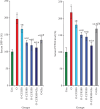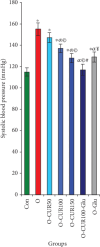Protective Effects of Isolated Curcumin From Curcuma longa on Key Enzymes Involved in the Insulin Signaling Pathway and Digestive and Metabolic Enzymes Associated With Obesity, Type 2 Diabetes, and Hypertension
- PMID: 40376699
- PMCID: PMC12081152
- DOI: 10.1155/jdr/8050374
Protective Effects of Isolated Curcumin From Curcuma longa on Key Enzymes Involved in the Insulin Signaling Pathway and Digestive and Metabolic Enzymes Associated With Obesity, Type 2 Diabetes, and Hypertension
Abstract
This study explores the potential of curcumin (CUR), extracted from Curcuma longa, in combating obesity and Type 2 diabetes. Obesity and Type 2 diabetes were induced in rats through a high-fat and high-fructose diet (HFFD), and CUR, after purification and characterization by Fourier transform infrared spectroscopy (FTIR) and ultraviolet (UV) spectroscopy, was administered for 3 months via gastric gavage. The results show that CUR supplementation activates the insulin signaling pathway in a dose-dependent manner, leading to improved insulin sensitivity. Specifically, administering CUR at a daily dose of 100 mg/kg significantly reduces the activities of protein tyrosine phosphatase (PTP1B) and dipeptidyl peptidase-4 (DPP-4) by 43% and 45%, respectively, in obese and Type 2 diabetic rats compared to untreated obese rats. Furthermore, CUR effectively inhibits lipase and α-amylase activities at both the serum and intestinal levels. In obese rats, CUR administration reduces glycogen phosphorylase (GP) activity by 35% and enhances glycogen synthase (GS) activity by 78%, leading to a substantial increase in hepatic glycogen content. Additionally, CUR also led to a 21% reduction in food intake and a 12% decrease in water consumption. These changes contributed to significant reductions in the blood sugar and glycosylated hemoglobin (HbA1c) levels, with decreases of 59% and 53%, respectively. Additionally, administering CUR at a dose of 100 mg/kg body weight reduced thiobarbituric acid reactive substances (TBARSs), hydrogen peroxide (H2O2), and total oxidant status (TOS) in obese and diabetic rats, with reductions of 49%, 59%, and 58%, respectively. Furthermore, CUR demonstrates a strong regulatory effect on the levels of low-density lipoprotein cholesterol (LDL-C), high-density lipoprotein cholesterol (HDL-C), and total cholesterol (TC). Overall, these results underscore the CUR potential for treating and preventing diabetes and obesity.
Keywords: curcumin; diabetes; insulin signalization pathway; key enzyme; obesity.
Copyright © 2025 Munirah S. O. Alhar et al. Journal of Diabetes Research published by John Wiley & Sons Ltd.
Conflict of interest statement
The authors declare no conflicts of interest.
Figures









References
-
- Atlas D. IDF Diabetes Atlas . 7th. 2. Vol. 33. Int. Diabetes Fed; 2015. International Diabetes Federation. - PubMed
MeSH terms
Substances
LinkOut - more resources
Full Text Sources
Medical
Miscellaneous

